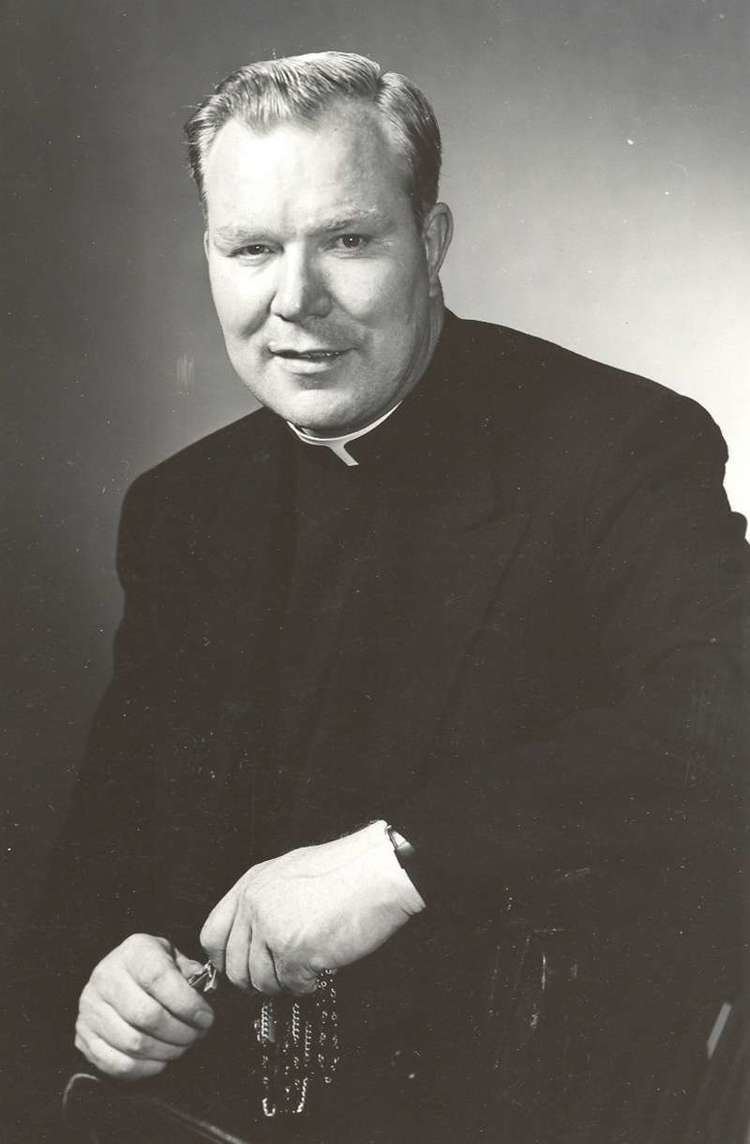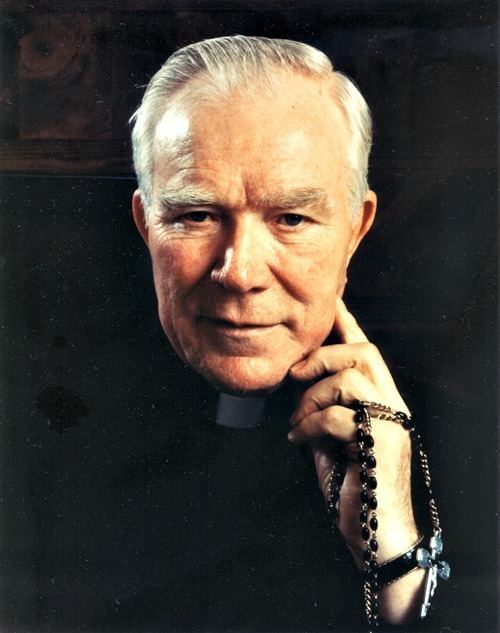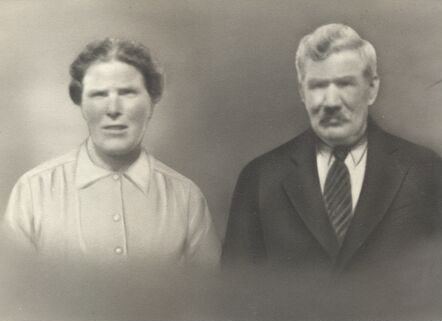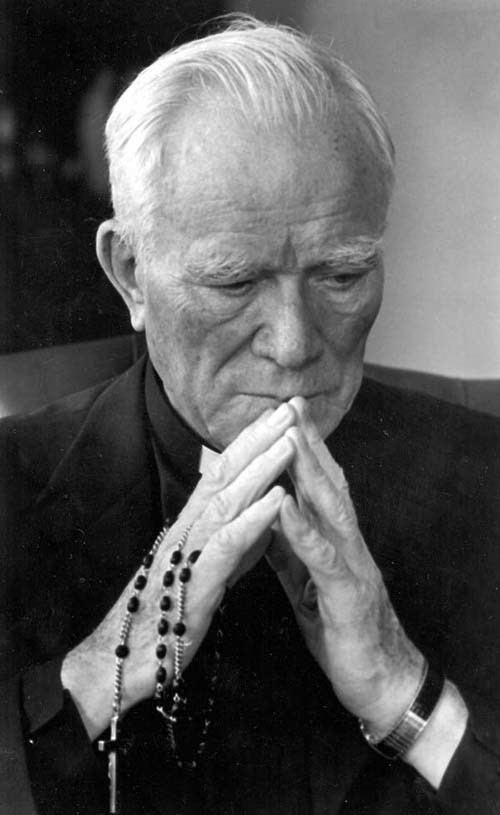Other names The Rosary Priest Role Priest Ordained June 15, 1941 | Name Patrick Peyton | |
 | ||
Died June 3, 1992, Los Angeles, California, United States | ||
Parents John Peyton, Mary Gillard | ||
Pray the luminous mysteries of the rosary with father patrick peyton csc
Servant of God Father Patrick Peyton, C.S.C. Patrick Peyton (January 9, 1909 – June 3, 1992), also known as The Rosary Priest, was an Irish Roman Catholic priest and promoter of the Rosary.
Contents
- Pray the luminous mysteries of the rosary with father patrick peyton csc
- Fr patrick peyton glorious mysteries of the most holy rosary
- Early life
- Meeting Holy Cross Fathers
- Marian Devotion
- Lifetime Crusade
- Death and legacy
- Sainthood
- References

Peyton is the founder of the "Family Rosary Crusade." Father Peyton staged massive Rosary rallies in key cities of the world and extensively utilized mass communication, helped by world-recognized celebrities of Hollywood at that time, promoting his ministry of binding families through prayer under the Family Rosary. Peyton was a popular and charismatic figure in Latin America and the Philippines, where he promoted the Rosary and was known for his strong Irish accent.

Peyton popularized the phrases "The family that prays together stays together" and "A world at prayer is a world at peace".

Fr patrick peyton glorious mysteries of the most holy rosary
Early life

Father Peyton was born as Patrick Joseph Peyton in County Mayo, Ireland to John Peyton of Carracastle and to the former Mary Gillard of Rathreedane, Townland of Bonniconlon, County Mayo.

Father Peyton was the sixth in a family of four girls and five boys living in a small cottage at a 14 acre (5.66 hectares) stony farmland near the foot of the Ox Mountains. The Peyton family was a deeply religious Irish Catholic subsistence-farming family. Later on, some members of the family migrated to the United States.

Peyton was one of the children having the privilege of going to school. Patrick was sent to his mother's relatives in Bonniconlon to study at a school run by Tadhg O’Leary in Bofield.
As a young man, Patrick was rebellious and had moments of defying authority, resulting in dropping out of school. Despite the youthful rebellion, he remained close to his family, respectful of his parents, and was deeply religious. By his teen years, he was contemplating a vocation to become a priest. Religious recruiters such as the Capuchins and the Redemptorist fathers visited Carracastle in search of young men wanting to pursue the priesthood.
His curiosity about pursuing a vocation was set aside for a couple of years. Instead he would concentrate in helping his family earn a living when their father became too ill and to work the farm. Some of his elder sisters were already in America and were sending remittances to help the family left behind. In 1927, his sisters in America sent word that Patrick and his older brother Thomas could sail to the United States and join them in Scranton, Pennsylvania. On May 13, 1928, the Peyton brothers set sail.
The brothers arrived in New York after a 10-day trip, traveling by steerage. A young Patrick, who had never left his country, was awed by the glamour of the well-off Irish people who were in the leisure cabins above deck. The two took the train from New York to Pennsylvania and lived at the home of their already married sister Beatrice, who was working as a housekeeper for the state Attorney General. Patrick's sister Nellie had already spoken to Monsignor Paul Kelly of the St. Stanislaus Cathedral and told of Patrick's inclination to pursue a priestly vocation. Monsignor Kelly told Nellie to bring her younger brother Patrick to the cathedral as soon as he arrived. By June 1928, with hard luck in finding a job, Patrick finally met Monsignor Kelly and was offered a job of becoming the cathedral's sexton. In the words of Patrick at that time, a sexton was just another name for a janitor.
Meeting Holy Cross Fathers
Peyton took the job with initial hesitation but his daily presence at the cathedral brought back the calling for a vocation and he finally decided to pursue the priesthood. Monsignor Kelly insisted that Patrick should complete his high school education prior to admission to the novitiate. He and his older brother Thomas both pursued their religious vocations while working at the cathedral. During the spring of 1929, Father Pat Dolan of the Congregation of Holy Cross came to the cathedral in Scranton in search of new seminarians. Patrick and his brother Thomas formally entered the main seminary of the Congregation of Holy Cross in Notre Dame, Indiana in 1932.
After completing their high school studies in a Holy Cross school in Notre Dame, Indiana, Patrick was admitted to the Moreau Seminary within the University of Notre Dame in 1932. Patrick pursued a degree in Bachelor of Arts. Patrick excelled in Philosophy. He credited Father Cornelius Hagerty, C.S.C., a professor of ethics, as the one who provided him with counseling. As a young seminarian, Patrick was attracted to become a Holy Cross Father for the order's focus towards the Holy Family and its precision towards obedience and conscience. Patrick also appreciated the order's instant availability to any instructions of the Catholic Church and the family-like atmosphere within the Congregation.
Marian Devotion
In October 1938, Patrick's health took a turn when he started coughing blood. For months he refused to acknowledge his hemorrhages until he could no longer concentrate on his work. On the night of February 6, he was brought to nearby Providence Hospital. Doctors discovered advanced stages of tuberculosis on the upper lobe of Patrick's right lung. At the start, Patrick was despondent and feared this was the end of his young life. His sister Nellie traveled to Notre Dame from Scranton and brought him novenas of the Blessed Mother. Nellie reminded Patrick of the never-ending love of the Blessed Mother and how their family lived the life of prayer, especially the Holy Rosary. Father Cornelius Hagerty was also influential in this stage of Patrick's life, encouraging the young seminarian to give it all up to God and seek the hand of the Blessed Virgin Mary. The doctors discovered that the patches in his lungs disappeared.
He immediately packed his bags and left for the Holy Cross College in Washington, D.C. to complete his theology studies and take his final vows. In May 1941, a special dispensation from the Vatican allowed Patrick to be ordained as a priest but he must complete his studies after being subjected to severe illness. On June 15, Patrick and his brother Thomas were finally ordained at the Basilica of the Sacred Heart in the University of Notre Dame as members of the Congregation of Holy Cross.
Lifetime Crusade
Reverend Patrick Peyton, C.S.C., was given very light duties following the completion of his theological studies. His first assignment was in Albany, New York as the chaplain of the Holy Cross Brothers of the Vincentian Institute. But he was certain that his return to health was for a different, specific purpose.
From Albany, New York, Father Peyton's mission started as letters of appeal to Bishops, the Catholic lay, even to non-Christians arguing and appealing the importance of the families praying the Family Rosary as the war raged on. Father Peyton won points for his mission to bring families together later on especially after the end of the war.
Utilizing radio, films, outdoor advertising and later television, with the help of celebrities, artists and advertising practitioners, Father Peyton was one of the first pioneers of evangelism using mass media.
He would also pioneer in conducting public rallies to bring families to pledge to pray the Rosary as a unit. These Rosary rallies attended by millions would become the most significant event where Father Peyton could be best remembered. According to historian Hugh Wilford, "Peyton himself was deeply conscious of the political dimension of his mission, proudly proclaiming in a 1946 radio broadcast, 'The rosary is the offensive weapon that will destroy Communism—the great evil that seeks to destroy the faith'" (The Mighty Wurlitzer: How the CIA Played America [Cambridge and London: Harvard University Press, 2008], p. 187).
These Rosary Crusades were duplicated in different dioceses with attendees growing in numbers taking Father Peyton across the globe from Brussels, Belgium to Madrid, Spain across Asia to Manila, Philippines, down south of the equator to New Zealand and Papua New Guinea and into several South American cities like Lima, Peru to Rio de Janeiro in Brazil.
With the help of a non-Catholic advertising practitioner, Father Peyton would popularize the slogan "The family that prays together stays together."
Death and legacy
With a Cold War threatening a new world peace, Father Peyton was highly instrumental in promoting prayers, winning the hearts of leaders and non-Christians, making visible the messages of the Blessed Virgin Mary, including the recognition from the Vatican from Pope Pius XII to Pope John Paul II. His efforts throughout the tumultuous period of human history in the 20th century earned him the title "The Rosary Priest".
Controversy hounded Father Peyton throughout his ministry as some accused him of being a front for American intelligence during his missions in Latin America. Father Peyton's Rosary Crusades in Latin America were funded and, to some extent, directed by the Central Intelligence Agency, which was interested in combating leftist political movements in Latin America. This came about through Father Peyton's connection to J. Peter Grace, the great-grandson of the founder of W.R. Grace and Company, a multinational corporation with interests in transport, sugar, and mining in South America, whom Peyton had met in 1946 on a trans-Atlantic voyage. Grace, who was involved with other CIA front operations as well, wrote to John Moore, the chair of the Business Advisory Council, and the two men approached Allen Dulles. Dulles later met with Grace in the White House office of Vice President Richard Nixon, who expressed enthusiasm. The CIA decided for several years where the crusades would take place, and CIA funds were expended in Chile, Brazil, Venezuela, and Colombia, until Peyton's provincial superior, Richard H. Sullivan, learned of the secret funding from Theodore Hesburgh, the chair of the board of trustees of the University of Notre Dame, in October 1964. It took the Vatican more than a year and a half to oblige Father Peyton to give up his CIA financing While the CIA determined the locations of the Crusades, it did not influence the methods employed or Father Peyton's goal of promoting family prayer, the Rosary and devotion to the Blessed Mother.
Others accused Father Peyton of living an ostentatious lifestyle, living a life with Hollywood artists who volunteered their efforts in helping promote his mission. But Father Peyton maintained that he never solicited funds for his ministry, and the well-off were more than generous to voluntarily donate a portion of their wealth all in the name of the Blessed Mother.
Father Patrick Peyton, C.S.C., died peacefully holding a Rosary in a very small room on June 3, 1992 in San Pedro, California. His remains were brought to the Holy Cross Cemetery on the grounds of Stonehill College in Easton, Massachusetts.
Before Father Peyton died, he continued to work on what was to be the last major Rosary Rally. On December 8, 1992 at the Rizal Park in Manila, the Philippines, Manila Cardinal Archbishop Jaime Sin led the celebrations for the Golden Jubilee Celebration of the Family Rosary Crusade. Then the Cardinal Archbishop of Los Angeles, Roger Mahony was sent as Papal Legate on behalf of Pope John Paul II. Among Filipino Catholics, Father Patrick Peyton is heavily remembered for his Sunday televised shows, where he promoted the Rosary and Marian devotion along with his famous slogan. Peyton also encouraged many businesses to start making and selling large amounts of Rosaries for distribution, which he gave freely to impoverished Filipinos living in the slums.
Servant of God Patrick Peyton's work continues today in his original Ministries, Family Rosary, Family Theater and Family Rosary International, and in the Father Patrick Peyton Family Institute.
Sainthood
Cardinal Sean Patrick O’Malley announced a formal declaration opening the cause for sainthood of Father Peyton on June 1, 2001, a few days after receiving approval from the Vatican's Congregation for the Causes of the Saints. The declaration paved the way for the process of determining Father Peyton's holiness and in the process earning the revered title of "Servant of God."
The Positio was sent to the C.C.S. in 2015 for assessment and theologians approved his cause on 1 June 2017.
